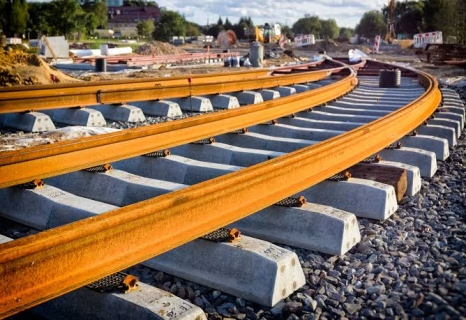Updated October 31, 2025- Angola is seeking $4.5 billion in funding to build an ambitious rail link to neighboring Zambia’s copper-rich region, Transport Minister Ricardo Viegas d’Abreu said.
Italy has committed $320 million to the plan and African Development Bank $500 million, he told reporters Wednesday on the sidelines of a conference in Luanda, Angola’s capital. The Egyptian government this week expressed interest in financing the project, he said.
The new Zambian spur forms part of a much bigger project known as the Lobito Corridor that seeks to connect the region, boosting trade in minerals as well as agriculture.
The cost estimate for the US-backed rail project is significantly higher than previous ones for the 800-kilometer project, on which construction is set to start next year. The Africa Finance Corp., which won the concession to oversee it, has avoided putting a price tag before it puts the work out to tender in the coming months.
The project will connect Zambia’s copper mines to an existing Lobito line that runs from the Atlantic port city into the Democratic Republic of Congo.
In another ambitious rail project that is set to rival the Lobito Corridor, the Chinese backed Tanzania-Zambia Railway (Tazara) is gearing up for development following the recent plans by China to rehabilitate the rail corridor at $1.4 billion. Also, these railway projects are an indication of the scramble of control by Western countries especially between China and the US.

Updated September 30, 2025- Lobito Corridor is a major trans-African infrastructure project centered on a railway line that links the port of Lobito on Angola’s Atlantic coast with the mineral-rich regions of the Democratic Republic of Congo (DRC) and Zambia, specifically the Copperbelt. This corridor is primarily seen as a critical trade route designed to provide a shorter, faster, and more efficient path for exporting minerals such as copper and cobalt, essential for the global energy transition to international markets, particularly the US and Europe.
Recent developments underscore the corridor’s geopolitical and economic significance. The project has garnered substantial financial and diplomatic backing from the United States and the European Union through the G7’s Partnership for Global Infrastructure and Investment (PGII), with total international investment commitments exceeding $6 billion.
However, the project also faces challenges which include competition from rival East African routes such as the Tazara which is backed by China. Recently, China inked a $1.4 billion deal with Tanzania and Zambia that will foresee the rehabilitation of Tazara. With the Tazara rehabilitation now gaining momentum, this will be a rival for the Lobito Corridor Development Project in moving minerals.

Reported on May 19, 2024
The mineral-rich country of Angola has signed the Lobito Corridor Development Deal that will foresee the funding of three key infrastructure projects in the Lobito Corridor that amount to a total of US$1.3 billion.
The deal that was reached by the two sides is a part of the plan of the United States, the European Commission, African Development Bank (AfDB), Africa Finance Corporation, Angola, Democratic Republic of Congo (DRC), and Zambia for the development of the 1,300-kilometer railway line that is set to link Angola to the Atlantic Ocean.

Inside the Lobito Corridor Development Deal
In this Lobito Corridor Development Deal that was signed by Angola and the United Sates, US Export-Import Bank (EXIM) shall provide a total of US$872 million to Angola that will enable the construction of a total of two solar power plants both having the capacity of generating over 500MW of renewable energy.
The two solar power plants will be constructed by the US developer, Sun Africa. These solar power plants will foresee the improvement of access to electricity, clean water for industrial and domestic use, and the irrigation systems that are scattered across Angola.

Moreover, the US$450 million Acrow Bridge project will in the meantime get to oversee the engineering, procurement, and the establishment of a total of 186 bridges in Angola. Additionally, an investment of US$40 million swill supply a total of 168 Flexiva FM transmitters, the installation works of antennae, establishment of towers, the auxiliary RF systems and upgrading of the studio. Radio is deemed as one thriving medium in the African continent, Angola being inclusive where it still outdoes social and the internet as sources of news.

The Lobito Corridor project is an attempt by the United States of America (USA) and the European Union (EU) to secure a very crucial supply of raw materials and valuable minerals in the region in order to catch up with the Chinese rivalry that poses a threat for their influence in the region. Currently, China has established advanced supply chains in the African continent, for the likes of minerals such as cobalt and lithium. As experts say, however, the Lobito Corridor Development Deal may be coming in “too late in the day.”
US-China Rivalry in Africa
In a race to becoming Africa’s partner of choice amid the competitive rush of securing crucial minerals that are needed to power the green energy revolution, the US and its European allies are committed to finance the existing 1,300-kilometer Lobito Atlantic Railway that links the three countries of Angola, Zambia, and the DRC, as well as establishing another brand new railway line that shall link Zambia to Angola. When combined, these upcoming railway projects clearly represent the largest railway investment in Africa by Washington DC in many years.

These two projects will greatly overlap with the Benguela corridor which was first constructed during the colonial era and refurbished from the year 2006 to 2014 by the China Railway Construction Corporation Limited (CRCC) after it was destroyed at the times of the occurrence of the Angola Civil War. Additionally, the Chinese CRCC was just recently awarded the contract of revamping the Tanzania-Zambia Railway (Tazara).
Also read: $1 Billion Chinese Tazara Revamp Proposal Issued
Lobito Corridor USA Investment to Amount to US$360 Million
Tanzania Plans for $5.6 Billion Mtwara-Mbamba Bay Railway Project

